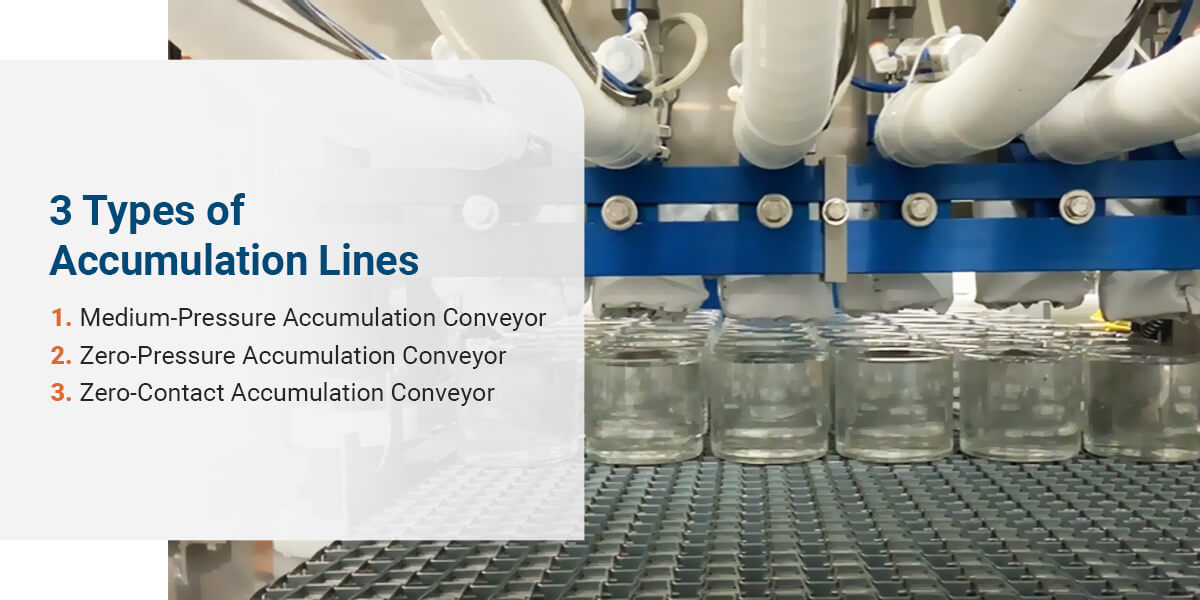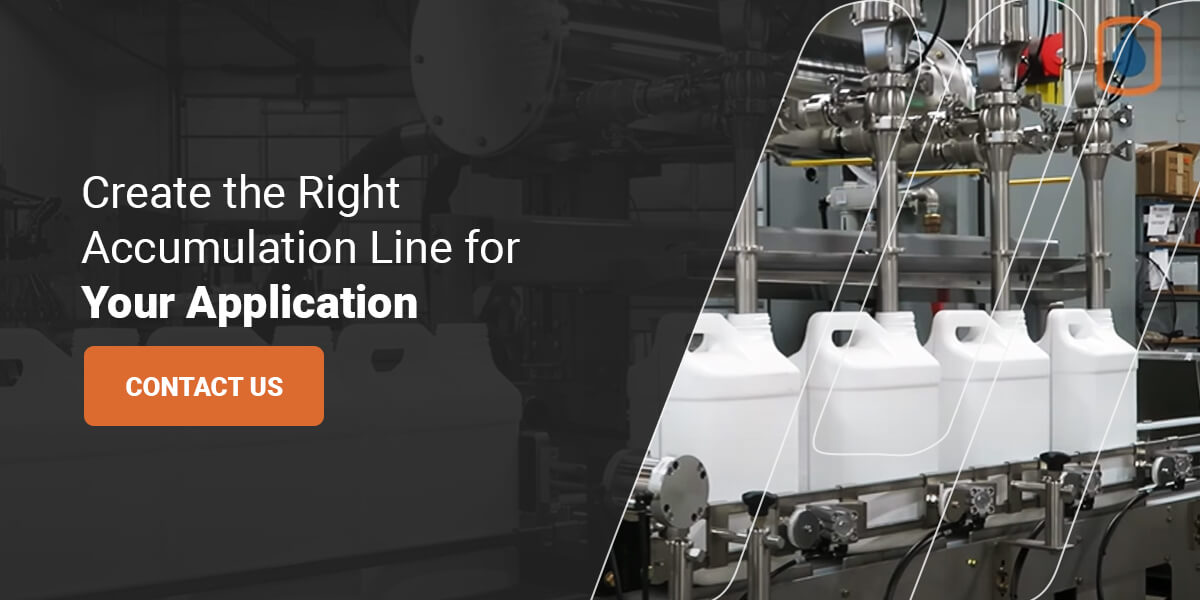21 April 2023 //

Packers can face challenges loading products at the rate they move into their station. Accumulation systems slow this stream, creating a collection pool they can easily pick from. They also allow users to supervise multiple stations simultaneously, moving between work areas as needed.
Accumulation conveyors allow processing lines to run uninterrupted, delivering a steady product flow to your packaging equipment. They help prevent product delay or damage while optimizing efficiency. If you’re considering investing in this technology for your packaging operations, this guide will explore the available types.
3 Types of Accumulation Lines
Three types of accumulation conveyors commonly regulate product flow in packaging applications — medium-pressure, zero-pressure, and zero-contact.
1. Medium-Pressure Accumulation Conveyor
A medium-pressure accumulation conveyor uses a flat drive belt that applies pressure to conveyor rollers, preventing products from crushing or jamming. The drive continues to run as materials accumulate, resulting in collected products.
Medium-pressure accumulation is most suitable for products with a consistent size and weight. When product size varies, the back pressure can cause larger objects to pivot around smaller ones during the accumulation process. That pivoting can lead to side-by-sides and downstream flow setbacks. Additionally, back pressure can damage products due to inadequate protection from fragile packaging.
Medium-pressure accumulation is most effective in environments with minimal accumulation requirements, like minor or occasional downstream delays.
2. Zero-Pressure Accumulation Conveyor
A zero-pressure accumulation conveyor contains sections of rollers that drop in sequence as items accumulate. The conveyor system has a flat, thin belt or padded chain that applies pressure to the rollers to move products.
As a downstream-moving object approaches an accumulated item, pneumatic actuators emit air to remove pressure on the rollers and reduce the drive mechanism. The product slows and gently coasts into place against the accumulated item.
There is no driving pressure on accumulated items, hence the name “zero-pressure.” Zero-pressure accumulation can prevent jams, product damage, side-by-sides, and air gaps from accrued items.
These conveyor systems are ideal for products of different sizes and weights. Zero-pressure accumulation conveyors are typically positioned before and after sorting machines, feeding merges and leading to shipping docks.
3. Zero-Contact Accumulation Conveyor
A zero-contact accumulation conveyor instantly stops accumulation zones, preventing products from coasting to a stop and hitting each other. These conveyors generally include one or two motor-driven rollers (MDRs). O-bands join the MDRs to other non-powered rollers to manage accumulation zones. Zero-contact accumulation typically provides the best control and lowest risk of product damage.
These systems leave space between products during the accumulation process, dividing conveyors into zones that each hold one item. They’re ideal when working with fragile products, as the conveyor doesn’t allow items to come into contact. Zero-contact accumulation is also effective for objects of different sizes and weights.
Additionally, an MDR system uses “run-on-demand” technology that conserves energy by only operating to move products between zones when necessary. It has minimal operating noise and no back pressure on the accumulated item. However, it usually has a lower product throughput rate than zero-pressure and medium-pressure accumulation.
Accumulation Lines for Your Application
At DTM Packaging, we create custom packaging equipment solutions. We help clients design, manufacture, and install a variety of systems to streamline and accelerate their packaging processes. We can develop accumulation solutions for numerous applications, such as the ones below.
- Bottles: Bottling liquid products involves filling and sealing containers efficiently, accurately, and securely. We can help you develop a reliable conveyor system to move bottles and cases to their proper locations quickly.
- Bundling: If your operations involve bundling and shrink-wrapping products, our accumulation conveyor systems can help move items through the production line with ease, facilitating your overall workflow.
- Caps: Capping involves applying lids and closures to containers, requiring speed and accuracy. Our capping machinery includes conveyor systems to move containers efficiently down the line, enabling more efficient capping.
- Cleaning: Packaging cleaning solutions help ensure sanitary processes by removing contamination sources. They prevent and eliminate dirt and debris in containers and surfaces. An accumulation conveyor system makes it easier to stop and accumulate products for thorough cleaning.
- Conveying: Conveying systems transfer containers between machines. You can clean, fill, cap, and label each item while moving down the production line. Accumulation technology can move, stop, and accumulate items as needed to simplify these processes.
- Dose cups: Dose cup packaging equipment places dose cups on bottles as they move down the line. An accumulation system can help prevent containers from jamming or contacting each other during this process.
- Feeding: Feeding machines connect directly to conveyors, moving products between different conveyor sections to undergo different packaging processes. An accumulation system can help improve your feeding machine’s efficiency, preventing clogged or damaged products between packaging stages.
- Integration application solution: A packaging line integration solution links several machines to fulfill different elements of the packaging process. Accumulation technology helps create a smoother product flow between these steps.
- Labeling application solution: Labeling application machinery applies adhesive labels to products with speed and precision. Manufacturing companies need a reliable solution that prevents items from jamming, damaging, and slowing down the labeling process. An accumulation line can help ensure efficient labeling.
- Liquid filling: In beverage production facilities, liquid-filling machines play an important role in packaging. They can fill many types of bottled drinks, including water, juice, soda, and alcohol, while maintaining product quality and cleanliness. An accumulation conveyor can move and stop containers as needed for efficient, mess-free filling.
- Material handling: A high-quality accumulation line plays an essential role in material handling applications. Material handling involves transporting, sealing, filling, and wrapping containers with accuracy and speed. An accumulation conveyor system can keep products secure throughout the production line.
- Sealing: Many industries rely on sealing packaging machines to seal packages accurately and efficiently, keeping the contents enclosed and secure. Accumulation technology can prevent product contact and damage during sealing, helping you avoid costly setbacks.
- Sorting: Sorting machinery sorts and packages products in many industries, boosting accuracy and production rates. Installing accumulation conveyors before and after sorting machines helps prevent side-by-sides and ensures efficient transfer into feeding machines.
Create the Right Accumulation Line for Your Application
Are you ready to incorporate accumulation technology into your packaging operations? DTM Packaging can help. Serving a range of industries from food production to cosmetics and pharmaceuticals, we’ll work with you to customize an accumulation line to your unique needs. Contact our team today to get started!




